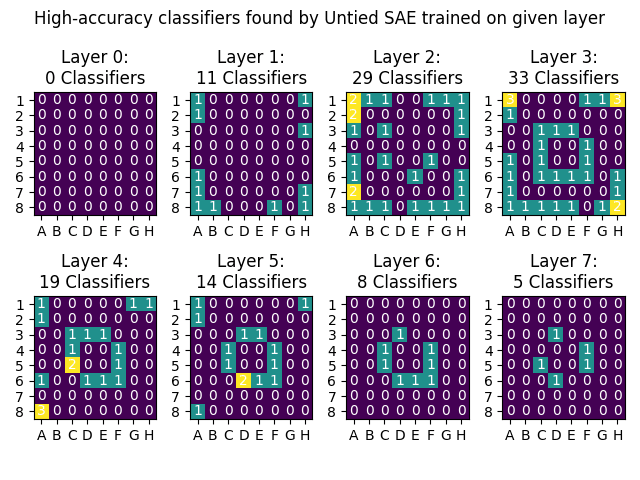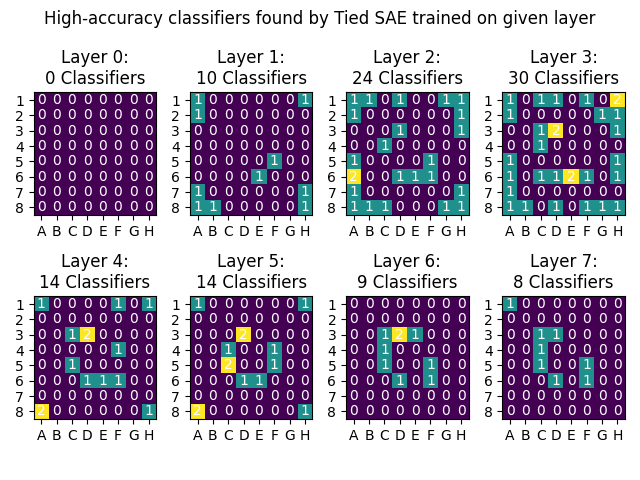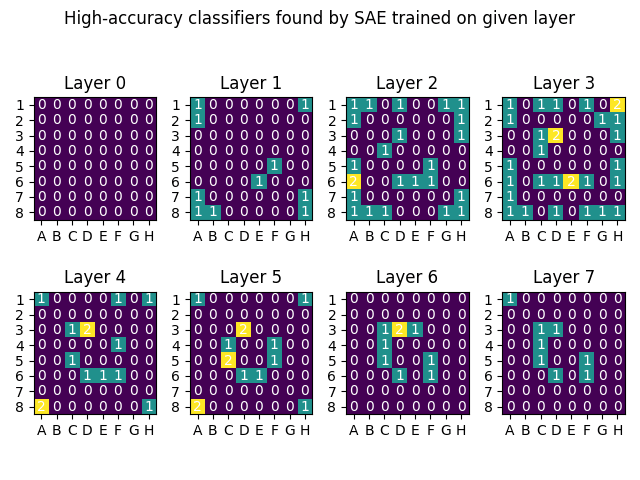Sincere response: Could work, but I weep for the lost clarity caused by sen and ten rhyming. Our current digits are beautifully unambiguous this way, whereas our alphabet is a horrible lost cause which had to be completely replaced over low-fidelity audio channels.
Sarcastic response: I'll agree iff 10 becomes teven.
I do believe "lower-activating examples don't fit your hypothesis" is bad because of circuits. If you find out that "Feature 3453 is a linear combination of the Golden Gate (GG) feature and the positive sentiment feature" then you do understand this feature at high GG activations, but not low GG + low positive sentiment activations (since you haven't interpreted low GG activations).
Yeah, this is the kind of limitation I'm worried about. Maybe for interpretability purposes, it would be good to pretend we have a gated SAE which only kicks in at ~50% max activation. So when you look at the active features all the "noisy" low-activation features are hidden and you only see "the model is strongly thinking about the Golden Gate Bridge". This ties in to my question at the end of how many tokens have any high-activation feature.
Anthropic suggested that if you have a feature that occurs 1/Billion tokens, you need 1 Billion features. You also mention finding important features. I think SAE's find features on the dataset you give it.
This matches my intuition. Do you know if people have experimented on this and written it up anywhere? I imagine the simplest thing to do might be having corpuses in different languages (e.g. English and Arabic), and to train an SAE on various ratios of them until an Arabic-text-detector feature shows up.
I'm sure they actually found very strongly correlated features specifically for the outlier dimensions in the residual stream which Anthropic has previous work showing is basis aligned (unless Anthropic trains their models in ways that doesn't produce an outlier dimension which there is existing lit on).
That would make sense, assuming they have outlier dimensions!
Non-exhaustiveness seems plausible, but then I'm curious how they found these features. They don't seem to be constrained to an index range, and there seem to be nicely matched pairs like this, which I think isn't indicative of random checking:
Cool work! Some questions:
- Do you have any theory as to why the LLM did worse on guessing age/sexuality (relative to both other categories, and the baseline)?
- Thanks for including some writing samples in Appendix C! They seem to all be in lowercase, was that how they were shown to the LLM? I expect that may be helpful for tokenization reasons, but also obscure some "real" information about how people write depending on age/gender/etc. So perhaps a person or language model could do even better at identity-guessing if the text had its original capitalization.
- More of a comment than a question: I'd speculate that dating profiles, which are written to communicate things about the writer, make it easier to identify the writer's identity than other text (professional writing, tweets, etc). I appreciate the data availability problem (and thanks for explaining your choice of dataset), but do you have any ideas of other datasets you could test on?
Ah sorry, I skipped over that derivation! Here's how we'd approach this from first principals: to solve f=Df, we know we want to use the (1-x)=1+x+x^2+... trick, but now know that we need x=I instead of x=D. So that's why we want to switch to an integral equation, and we get
f=Df
If=IDf = f-f(0)
where the final equality is the fundamental theorem of calculus. Then we rearrange:
f-If=f(0)
(1-I)f=f(0)
and solve from there using the (1-I)=1+I+I^2+... trick! What's nice about this is it shows exactly how the initial condition of the DE shows up.
Followup on tied vs untied weights: it looks like untied makes a small improvement over tied, primarily in layers 2-4 which already have the most classifiers. Still missing the middle ring features though.
Next steps are using the Li et al model and training the SAE on more data.
Likewise, I'm glad to hear there was some confirmation from your team!
An option for you if you don't want to do a full writeup is to make a "diff" or comparison post, just listing where your methods and results were different (or the same). I think there's demnad for that, people liked Comparing Anthropic's Dictionary Learning to Ours
I've had a lot of conversations with people lately about OthelloGPT and I think it's been useful for creating consensus about what we expect sparse autoencoders to recover in language models.
I'm surprised how many people have turned up trying to do something like this!
What is the performance of the model when the SAE output is used in place of the activations?
I didn't test this.
What is the L0? You say 12% of features active so I assume that means 122 features are active.
That's correct. I was satisfied with 122 because if the SAEs "worked perfectly" (and in the assumed ontology etc) they'd decompose the activations into 64 features for [position X is empty/own/enemy], plus presumably other features. So that level of density was acceptable to me because it would allow the desired ontology to emerge. Worth trying other densities though!
In particular, can you point to predictions (maybe in the early game) where your model is effectively perfect and where it is also perfect with the SAE output in place of the activations at some layer? I think this is important to quantify as I don't think we have a good understanding of the relationship between explained variance of the SAE and model performance and so it's not clear what counts as a "good enough" SAE.
I did not test this either.
At a high level, you don't get to pick the ontology.
I agree, but that's part of what's interesting to me here - what if OthelloGPT has a copy of a human-understandable ontology, and also an alien ontology, and sparse autoencoders find a lot of features in OthelloGPT that are interpretable but miss the human-understandable ontology? Now what if all of that happens in an AGI we're trying to interpret? I'm trying to prove by example that "human-understandable ontology exists" and "SAEs find interpretable features" fail to imply "SAEs find the human-understandable ontology". (But if I'm wrong and there's a magic ingredient to make the SAE find the human-understandable ontology, lets find it and use it going forward!)
Separately, it's clear that sparse autoencoders should be biased toward local codes over semi-local / compositional codes due to the L1 sparsity penalty on activations. This means that even if we were sure that the model represented information in a particular way, it seems likely the SAE would create representations for variables like (A and B) and (A and B') in place of A even if the model represents A. However, the exciting thing about this intuition is it makes a very testable prediction about combinations of features likely combining to be effective classifiers over the board state. I'd be very excited to see an attempt to train neuron-in-a-haystack style sparse probes over SAE features in OthelloGPT for this reason.
I think that's a plausible failure mode, and someone should definitely test for it!
I found your bolded claims in the introduction jarring. In particular "This demonstrates that current techniques for sparse autoencoders may fail to find a large majority of the interesting, interpretable features in a language model".
I think our readings of that sentence are slightly different, where I wrote it with more emphasis on "may" than you took it. I really only mean this as an n=1 demonstration. But at the same time, if it turns out you need to untie your weights, or investigate one layer in particular, or some other small-but-important detail, that's important to know about!
Moreover, I think it would best to hold-off on proposing solutions here
I believe I do? The only call I intended to make was "We hope that these results will inspire more work to improve the architecture or training methods of sparse autoencoders to address this shortcoming." Personally I feel like SAEs have a ton of promise, but also could benefit from a battery of experimentation to figure out exactly what works best. I hope no one will read this post as saying "we need to throw out SAEs and start over".
Negative: I'm quite concerned that tieing the encoder / decoder weights and not having a decoder output bias results in worse SAEs.
That's plausible. I'll launch a training run of an untied SAE and hopefully will have results back later today!
Oh, and maybe you saw this already but an academic group put out this related work: https://arxiv.org/abs/2402.12201
I haven't seen this before! I'll check it out!
[Continuing our conversation from messages]
I just finished a training run of SAEs on the intermediate layer of my OthelloGPT. For me it seemed like the sweet spot was layers 2-3, and the SAE found up to 30 high-accuracy classifiers on Layer 3. They were located all in the "inner ring" and "outer ring", with only one in the "middle ring". (As before, I'm counting "high-accuracy" as AUROC>.9, which is an imperfect metric and threshold.)
Here were the full results. The numbers/colors indicate how many classes had a high-accuracy classifier for that position.



One of my fascinations is when/how the Department of Defense starts using language models, and I can't help but read significance into this from that perspective. If OpenAI wants that sweet sweet defense money, having a general on your board is a good way to make inroads.